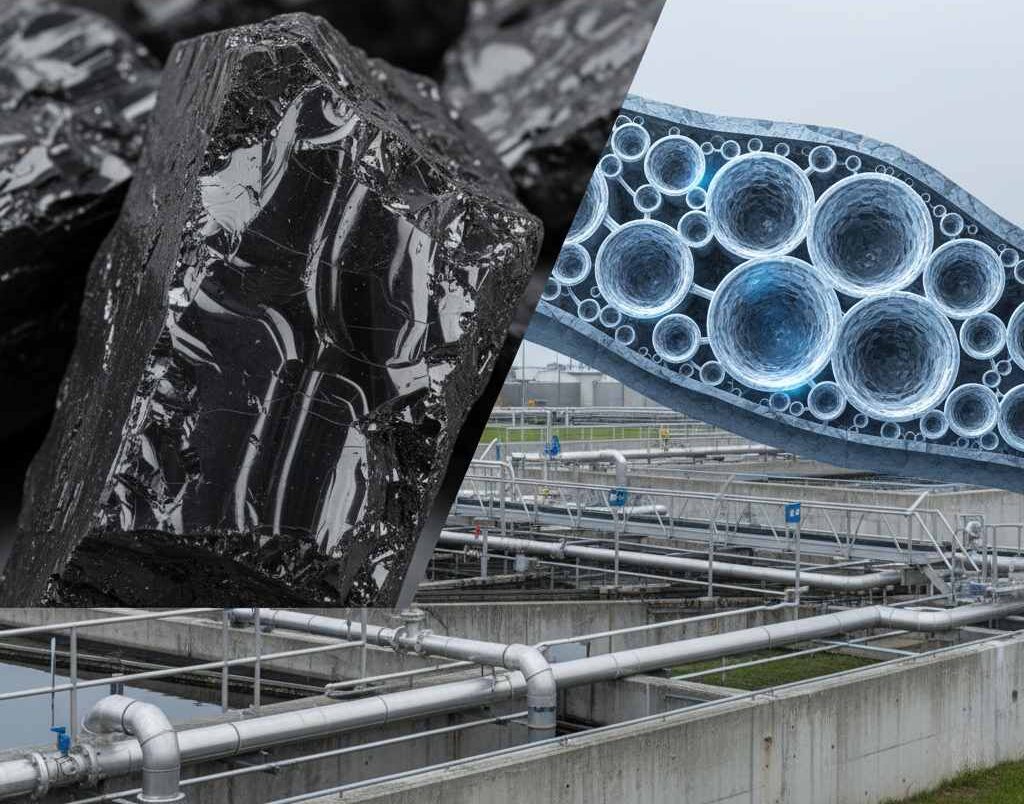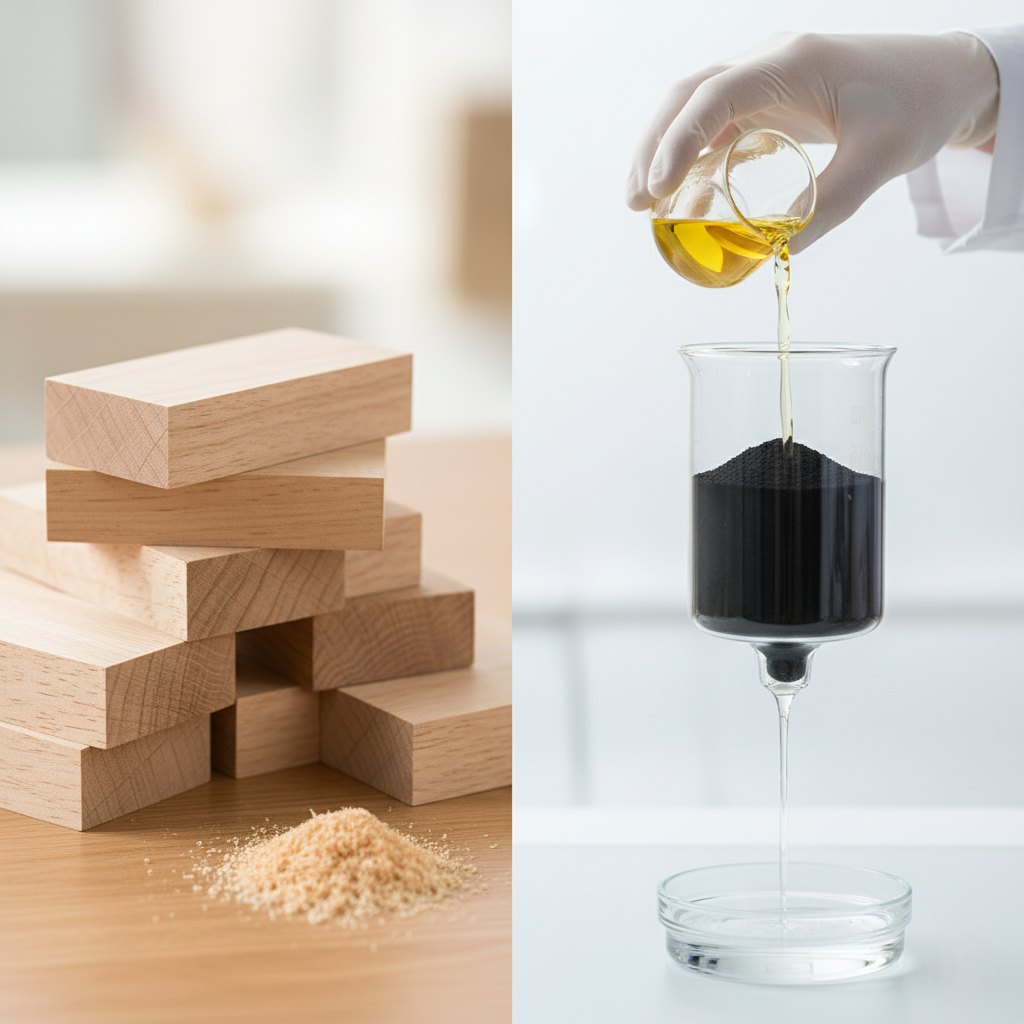1.0 The Starting Point of Purity: Why PAC Raw Materials Matter
1.1 The Unseen Foundation of High-Performance PAC
The final characteristics of a PAC product—its pore structure, density, and adsorptive capacity—are not merely outcomes of the manufacturing process; the DNA of its original feedstock fundamentally imprints them. Whether sourced from ancient coal seams, sustainable forests, or tropical coconut groves, the base material dictates the carbon’s inherent properties. This guide delves into the sourcing and manufacturing journey, providing the foundational knowledge required to move beyond the spec sheet and make truly informed procurement decisions.
1.2 How Source Material Directly Impacts Adsorption Capacity
The primary function of PAC is adsorption, a process entirely dependent on its vast internal surface area and intricate network of pores. These pores’ size, shape, and distribution determine which contaminant molecules the carbon can effectively capture. A material ideal for removing large color bodies will have a different pore structure than one optimized for trapping small, volatile organic compounds (VOCs). This structural variance is a direct consequence of the raw material, making understanding the source the first step in mastering your application.
2.0 A Profile of Primary PAC Feedstocks
The global supply of powdered activated carbon is derived from three primary categories of raw materials. Each possesses a unique cellular structure that, after activation, yields a distinct set of performance characteristics. Choosing the correct PAC is not about finding the “best” material overall, but the best material for a specific purification challenge.
2.1 Coal-Based PAC: The Industry Workhorse
Sourced from bituminous or sub-bituminous coal, this type of PAC has long been the standard for many large-scale applications. The rigid, dense nature of coal produces a carbon with exceptional hardness and a pore structure that is highly effective for general-purpose adsorption.

Pore Structure: Coal-based carbons typically feature a broad range of pores, from tiny micropores to larger transport macropores. This balanced distribution makes them versatile adsorbents, capable of capturing a wide variety of organic molecules of different sizes and shapes, making them particularly effective in municipal drinking water for taste and odor control.
Key Attributes: Known for its mechanical strength and density, coal-based PAC performs well in systems that involve significant physical agitation. Its cost-effectiveness at scale has cemented its role as an industry staple for decades.
2.2 Wood-Based PAC: The High-Purity Specialist
Produced from select hardwoods and sawdust, wood-based PAC is created through a chemical activation (often phosphoric acid) or steam activation. Wood’s softer, less dense nature produces a carbon with a unique pore structure geared toward specialized applications.
Pore Structure: The defining feature of wood-based PAC is its highly developed macroporous and mesoporous structure. These larger pores are not designed to trap small molecules. However, they are exceptionally efficient at capturing large color bodies, such as those found in food processing, pharmaceutical production, and chemical purification.
Key Attributes: Wood is a renewable resource, making sustainability a key advantage. The resulting carbon is of high purity and is often the preferred choice for applications where decolorization is the primary objective.

2.3 Coconut Shell-Based PAC: The Microporous Powerhouse
Derived from the hard, durable shells of coconuts, this feedstock is renowned for producing an activated carbon of exceptional quality and purity. As a byproduct of the coconut industry, it represents a highly renewable and sustainable source.
Pore Structure: Coconut shell-based PAC is characterized by a vast network of micropores—the smallest class of pores. This structure gives it an enormous internal surface area, making it the undisputed champion for adsorbing low-molecular-weight organic compounds and chlorine derivatives from potable water.
Key Attributes: Its superior hardness and resistance to attrition make it incredibly durable. Coconut shell PAC offers unparalleled performance for drinking water plants concerned with disinfection byproducts (DBPs) like trihalomethanes (THMs) or trace industrial contaminants.
Simulated Performance Comparison: Raw Material vs. Pore Structure
| Raw Material | Dominant Pore Structure | Primary Adsorption Target | Common Application |
|---|---|---|---|
| Coal | Mesoporous / Broad Range | Medium-sized Organics | Municipal Taste & Odor |
| Wood | Macroporous | Large Color Bodies | Food & Beverage Decolorization |
| Coconut Shell | Microporous | Small Organics, VOCs, DBPs | High-Purity Water, DBP Removal |
3.0 The Journey from Raw Material to Refined Product
The transformation of a raw feedstock into a high-performance adsorbent is a precise, multi-stage process. While the details are complex, understanding the core stages is essential for appreciating the importance of quality control from the beginning of the supply chain.
3.1 Supply Chain Integrity: The First Step in Quality Control
A consistent, high-quality PAC can only be produced from a consistent raw material. For industrial and municipal users, this is not a trivial point. A reliable PAC supplier must demonstrate an unwavering commitment to supply chain integrity, including:
- Traceability: The ability to trace a batch of PAC back to its raw material source and production date.
- Consistency: Rigorous testing of incoming raw materials ensures they meet strict moisture content, ash, and volatile matter specifications.
- Stability: A diversified sourcing strategy that mitigates risks from geopolitical instability, climate events, or logistical disruptions, ensuring an uninterrupted supply for critical operations.
3.2 Carbonization & Activation: Unlocking the Adsorptive Potential
Once a raw material is vetted, it undergoes a two-step transformation. First is carbonization, where the material is heated in an oxygen-deprived environment to remove impurities and create an elemental carbon “char.” The second, critical step is activation. This is where the magic happens. The char is subjected to high-temperature steam (or chemical reagents) that meticulously etch away at the carbon structure, developing the vast internal network of pores. This activation process’s temperature, pressure, and duration are carefully controlled and tailored to the feedstock to produce the desired final pore structure.
4.0 Sourcing for Modern Demands: Sustainability and Compliance
In today’s market, performance is no longer the sole purchasing driver. End-users are increasingly, and rightfully, demanding products that are not only effective but also sustainably sourced and compliant with stringent environmental and health regulations.
4.1 The Rise of Green Sourcing in the Carbon Industry
Sustainability is no longer a niche concern. For many organizations, it is a core component of their corporate social responsibility and brand identity. Sourcing PAC from renewable feedstocks like wood and coconut shells offers a significant environmental advantage over fossil fuel-based materials. Forward-thinking suppliers are not only offering these products. However, they also provide documentation and certifications regarding sustainable forestry practices and agricultural byproducts, allowing clients to meet their internal sustainability goals.
4.2 How Raw Material Purity Ensures Regulatory Peace of Mind
Regulatory compliance is non-negotiable for any entity treating drinking water or producing consumables. The purity of the powdered activated carbon is paramount. Standards like NSF/ANSI/CAN 61 certify that a product is safe for use in contact with drinking water and will not leach harmful contaminants. This certification is directly linked to the purity of the raw material. A feedstock with high levels of ash, heavy metals, or other impurities can compromise the final product, creating significant regulatory and public health risks. Sourcing from a supplier prioritizing high-purity raw materials is a direct investment in operational security and public trust.
5.0 Selecting a Supplier: A Partnership in Purity
Understanding the journey of powdered activated carbon from its raw origins to your facility transforms the procurement process. It shifts the focus from a simple price comparison to a strategic evaluation of a supplier’s quality, reliability, and expertise. The right supplier is not merely a vendor but a partner in your purification success.
5.1 Key Questions to Ask About Raw Material Traceability
Moving beyond the technical data sheet when engaging with a potential PAC supplier. Empower your decision-making by asking targeted questions about their sourcing practices:
- Can you provide traceability for the raw materials used in this specific product?
- What quality control measures do you have in place for incoming raw feedstocks?
- Do you offer products sourced from certified sustainable or renewable materials?
- How do you ensure the purity of your raw materials to meet standards like NSF 61?
5.2 Building a Resilient Purification Strategy with the Right Partner
Your PAC supply is a critical link in your operational chain. Choosing a partner with a transparent, robust, and resilient raw material supply chain is one of the most effective ways to de-risk your operations. It ensures the consistent performance required to meet your treatment objectives and the unwavering reliability to serve your community or customers without interruption. The source of your carbon truly is the source of your success.

